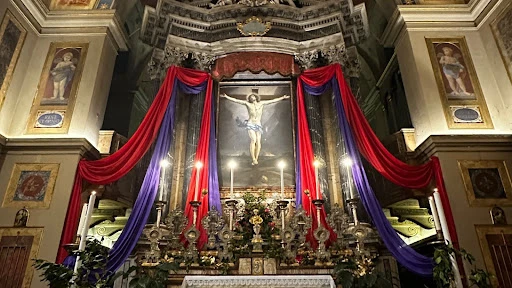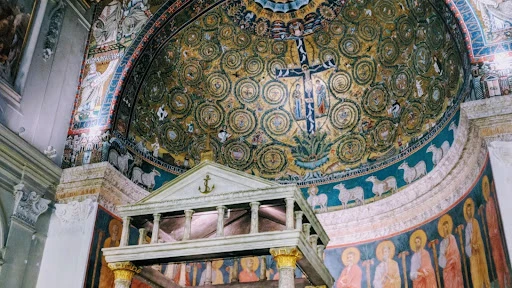Rome Newsroom, Mar 27, 2023 / 07:53 am
While many people choose to give up social media for Lent, one Catholic man is uploading new videos online every day to share the stories of the early Christian martyrs and Rome’s most ancient churches.
Jacob Stein is visiting a church in Rome each day of Lent this year, retracing the pilgrimage routes Catholics have walked for centuries as part of the Roman station church liturgical tradition.
Stein is sharing his experience on Crux Stationalis, a “social media apostolate” that seeks to bring the beauty and history of Rome’s Lenten station church tradition to YouTube, Instagram, Facebook, and his blog RomanStationChurch.com.
The American, who lives in Rome and started the Crux Stationlis YouTube and Instagram channels in Lent 2021, said he wanted “people to see Rome with its beauty and to understand the depths of Rome’s devotion to the martyrs.”
The Lenten station church pilgrimage in Rome dates back to the early fourth century and originally included daily papal processions in which people prayed the Litany of the Saints on the way to offer Mass at the burial site of the early Christian martyr assigned to that day.
St. Gregory the Great fixed the order of the original 25 church stations in the sixth century, which were later expanded, before the practice waned in the 14th century.
The videos bring social media users from the Ash Wednesday station church, the Basilica of Santa Sabina — first built in the year 432 A.D. and once home to St. Thomas Aquinas — to the Basilica of the Holy Cross of Jerusalem, which contains the long-venerated relics of Christ’s cross brought to Rome by Empress Helena, the mother of Constantine.
Stein studied philosophy and theology in Rome at the Angelicum before starting the social media apostolate.
What sets him apart from many social media influencers who share videos, reels, and photos of the beauty of the Eternal City is that he carefully researches the history and spiritual significance behind each church, sharing information about relics, liturgical prayers, art, and papal history.
“Crux Stationalis comes from the ancient tradition where each neighborhood in Rome would gather behind a cross which was called a ‘Crux Stationalis,’ a station cross, and they would process from one church to the next,” Stein explained.

The Roman station church tradition has experienced something of an Anglophonic revival in the last three decades, spearheaded by the Pontifical North American College, which in recent years has offered a 7 a.m. Mass in English at the station churches each day of Lent.
Stein, however, has been attending the Italian Masses in the evening organized by the Pontifical Academy of Martyrs for the Diocese of Rome. He said that he likes to be connected with the local church.
And as an added bonus, the Italian Masses often begin with a procession with a relic of the true cross as the congregation sings the Litany of the Saints.
(Story continues below)
“With this Roman Station Church tour, you see the devotion of Rome,” he told CNA. “It’s going from the tomb of a martyr to another tomb of a martyr, and that really allows the communion of saints to be felt in a way that is just so tangible.”
“Tertullian said that ‘the blood of the martyrs is the seed of the Church,’ and you feel that with the Romans, they know that.”

In its modern form, the station church itinerary brings pilgrims to just over 40 churches between Ash Wednesday and the end of the Easter Octave, with repeated visits to some of the major and minor basilicas.
By participating in the pilgrimage, Stein has learned many things about the history of the Church in Rome, including the strong devotion to St. Lawrence in the Eternal City.
“We go to his churches everywhere during Lent. And [St. Lawrence] has more churches than Sts. Peter and Paul in his devotion here in Rome. In fact, the only one who has more churches devoted to her is Our Lady,” he said.
One of Stein’s favorite churches that he has come to know through the pilgrimage is the Basilica of Santa Pudenziana, which was built upon the second-century house of Roman senator St. Pudens, who allowed St. Peter to live in his house for at least six years.
According to tradition, the house was the site of the first Eucharist offered by St. Peter in Rome.
Stein pointed out that the basilica contains a fifth-century apse mosaic, “one of the oldest apse mosaics in Christendom.”
“St. Gregory of Nyssa says that the mosaic is an analogy for the Mystical Body of Christ, that each tessera [tile] is necessary,” he added.

Stein often goes live on Instagram and YouTube when he arrives at each church to give viewers an idea of the history of that day’s station church before the procession and Mass begins.
“Some of the comments that I get most often are ‘I feel like I’m walking through the churches,’” he said.
Stein joked that it has turned out to be “a penance” to keep up the daily filming and social media posts for the apostolate every day of Lent, but he knows that it is a worthwhile effort.
“The history of Rome is underneath us; paleochristian basilicas are there. And there’s a reason they were built and we should know that, or at least it’s our right to know it because it’s our patrimony,” he said.






